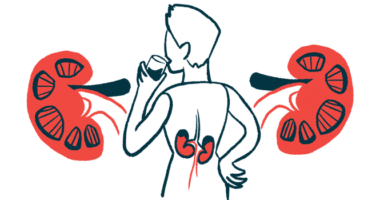Gazyva enhances standard care for lupus nephritis, Phase 2 trial finds
Two-year findings show lower risk of disease flares, kidney decline or failure

Adding Gazyva (obinutuzumab) to standard-of-care therapy for two years reduced the risk of treatment failure, diminished kidney function or death by 60% in people with lupus nephritis, a lupus complication marked by kidney inflammation and damage.
The number of lupus nephritis flares, or periods of sudden worsening, also dropped by more than half in patients given Gazyva as an add-on treatment relative to those given a placebo.
That’s according to a new analysis of data from the recently completed Phase 2 NOBILITY clinical trial (NCT02550652), whose previous findings showed that the experimental therapy more than doubled the likelihood of achieving complete kidney responses after up to 1.5 years.
“These data are really important because the ultimate goal of lupus nephritis therapy is to preserve kidney survival so patients never have to face the need for dialysis or transplantation because their kidneys failed,” Brad Rovin, MD, the study’s corresponding author at the Ohio State University Wexner Medical Center, said in a press release. “The addition of [Gazyva] to standard lupus nephritis therapy may increase the likelihood of achieving this goal.”
Phase 3 trial underway into Gazyva as an add-on lupus nephritis treatment
These data were detailed in the study, “Kidney Outcomes and Preservation of Kidney Function With Obinutuzumab in Patients With Lupus Nephritis: A Post Hoc Analysis of the NOBILITY Trial,” published in the journal Arthritis & Rheumatology.
A global Phase 3 trial, called REGENCY (NCT04221477), aims to confirm the efficacy and safety of Gazyva against a placebo, both given with standard care, in about 252 adults with lupus nephritis. Top-line data could be available in the fall or winter of next year, and the study is due to finish in 2029.
Lupus results when abnormal immune B-cells produce self-reactive antibodies that target various tissues, including the skin, joints, brain, heart, lungs, and kidneys.
About 40% of adults with lupus are eventually are diagnosed with lupus nephritis, a severe complication marked by a decline in kidney function. Many do not respond to approved lupus therapies and develop kidney failure, requiring dialysis or a kidney transplant.
Gazyva, developed by the Roche subsidiary Genentech and by Biogen, is an antibody-based therapy approved for certain types of blood cancers associated with malignant B-cells. It works by targeting CD20, a protein found at high levels at the surface of B-cells, which ultimately promotes the cells’ death.
Because of its mechanism of action, Gazyva is expected to deplete the hyperactive B-cells that drive autoimmune attacks in lupus, as well as to prevent excessive inflammation.
The Phase 2 NOBILITY study, sponsored by Roche, tested whether adding Gazyva to standard treatment regimens worked better than standard treatment alone in 125 lupus nephritis patients.
Patients were randomly assigned to an intravenous (into-the-vein) infusion of either 1,000 mg of Gazyva (63 patients) or a placebo (62 patients) on day one and weeks two, 24, and 26. All maintained a standard-of-care regimen of CellCept (mycophenolate mofetil) and corticosteroids, and they were followed for two years.
Top-line data showed that the trial achieved its main goal and several secondary goals, with Gazyva treatment being associated with a higher rate of complete or partial kidney responses after one year relative to standard care alone. The investigational therapy also was not linked to new safety concerns.
Interim, 1.5-year results showed that Gazyva more than doubled the proportion of patients who achieved a complete kidney response relative to a placebo (40% vs. 18%).
Rovin and colleagues conducted a post-hoc analysis, one specified after a study has concluded and all data were collected, of NOBILITY’s two-year findings to investigate long-term preservation of kidney function.
The time to an unfavorable kidney outcome was the primary goal of the analysis, as measured by a composite of all-cause treatment failure, a two times rise in blood creatinine levels — which indicates kidney decline — or all-cause death.
Results showed that after two years of treatment, Gazyva significantly reduced the risk of an unfavorable kidney outcome by 60% relative to a placebo.
Specifically, treatment failures were half as many among Gazyva-treated patients than those on standard treatment alone (12 vs. 24), and there were fewer deaths (one vs. four), and fewer cases of creatinine level doubling (one vs. six).
Lower risk of flares, markers of kidney decline seen with long-term treatment
Long-term Gazyva treatment also associated with a 57% lower likelihood of lupus nephritis flares and an 80%-91% lower chance of experiencing a first decline of 30%-40% in estimated glomerular filtration rate (eGFR), indicating poorer kidney function.
“Sustained eGFR declines of 30% or 40% were numerically lower in the [Gazyva] treatment group; however, because of the limited number of events, no statistical testing was performed,” the researchers wrote.
Overall, Gazyva significantly slowed, by about four times, the annualized eGFR decline over two years relative to a placebo.
Moreover, more patients in the Gazyva group could maintain a daily prednisone dose of 7.5 mg or less and achieve complete kidney response by 1.5 years (38% vs. 16%) and two years (38% vs. 22%). However, these group differences reached statistical significance only at 1.5 years.
Given that long-term use and/or high doses of prednisone and other glucocorticoids are associated with serious side effects, a therapy’s ability to reduce the need for such standard medications is viewed as an added patient benefit.
“Post hoc analyses of NOBILITY demonstrated that compared with standard-of-care therapy, [Gazyva] treatment resulted in superior preservation of kidney function and prevention of [lupus nephritis] flares,” the researchers wrote. Also, “more patients achieved [complete kidney responses] at [1.5 years] with less glucocorticoid use in the [Gazyva] group.”
Gazyva, “in combination with SOC [standard of care] therapy, is the first CD20-targeted biologic to show efficacy and safety in lupus nephritis compared with SOC therapy alone in [an appropriately controlled] study,” the team concluded.







